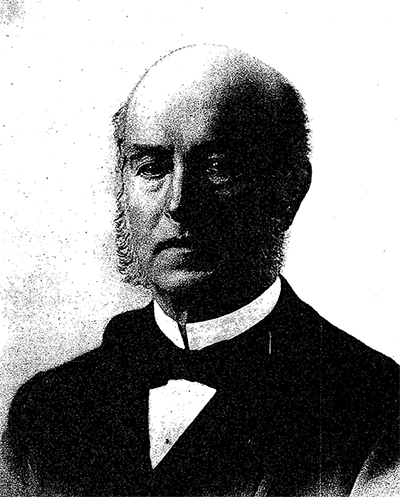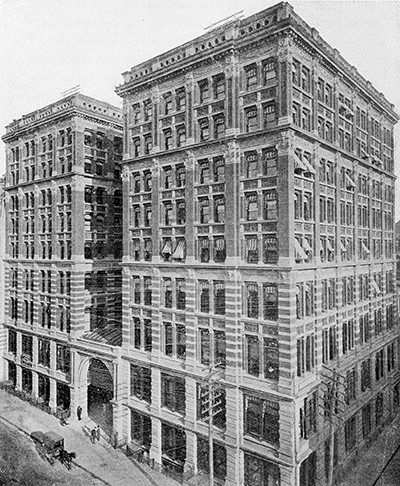Darius O. Mills, 1825 – 1910

Born on September 23, 1825, Darius O. Mills was a self-made man who hailed from simple farming folks in Westchester, N.Y.
For some time he was casting about to find his calling, and finally determined to become a banker. In this sphere he has proven himself a phenomenon. His talent for money making was early apparent, and he was appointed cashier of a bank in Buffalo when only twenty-one (Lewis 103-104).
At the age of 23, he left his job as a bank clerk, and moved to California with his brother Edgar in 1849. Darius benefited from the gold rush and made his fortune by trading gold and investing in railroads. He founded the bank D.O. Mills & Co. in Sacramento and by 1864, he headed the Bank of California:
In the course of a few years he became immensely rich through very successful trade and, as he was about to retire from active business, the Bank of California was projected. This he materially aided into existence,and as he was recognized as one of the ablest financiers in the city, he was chosen its first President. So well did he manage its affairs that it soon became the leading banking institution in the country, wielding an immense power in the financial world. He remained at its head for nine years when his private fortune had assumed such mammoth proportions that it demanded his immediate attention, he therefore resigned in 1873 (Lewis 104).
After a brief retirement, he returned to head the Bank after his successor had run it into the ground and committed suicide. Mills remained at the helm for three more years, returning it to a sound financial footing, when he resigned in 1878. He also invested widely in the early economic evolution of California, including land development, farming, mining, railroads, and education. Darius funded the Mills Professorship of moral and intellectual philosophy at the University of California, where he served on the Board of Regents, from 1860 – 1880.
He married Jane Templeton in New York on September 24, 1854.
In 1880, Mills moved his family to Fifth Avenue in New York City, where he invested in real estate:
His large business block, the Mills Building, ten stories high, fitted up for offices containing three hundred in all, is a magnificent structure. His wealth is very great, being estimated at from fifteen to twenty millions of dollars. He has established on the Pacific slope, at a cost of about two hundred thousand dollars, a seminary for young ladies (Lewis 105).
He funded the construction of three Manhattan hotels for poor men, including Mills' House n°1 (1897), a residence with 1,554 tiny, low-priced rooms, very strict rules, and affordable meals. It became known as a welfare hotel in the 1960s and was transformed into an apartment building known as the Atrium in the 1970s. The other two comparable hotels were built in 1905 and 1907, again financed by Mills. His objective in developing these residences stemmed from his belief that prosperous individuals had a responsibility to their community; his was a practical form of philanthropy that desired to help people help themselves:
We are too extravagant in this country [...] There is more waste here than in any other country. Persons of small means as well as persons of large means spend a great deal more money than is necessary to supply their needs [...] One of my objects in establishing the two model cheap hotels [...] was to encourage men of limited means to practice economy by enabling them to live comfortably at a very small outlay (cited in The New York Times, November 27, 1898, 27).
His lifelong interest in philanthropy and the arts inspired both of his children, guiding their charitable activities well into the 20th century.
Darius O. Mills died of heart failure on January 3, 1910 at the age of 84 at his Millbrae estate in California. His son, Ogden, had just left the estate, leaving him with Elisabeth Mills Reid had returned from Europe to help her ailing father. Mills bequeathed to his children the extraordinary sum of 60 million dollars. He also gave generously to institutions for whom he was a Trustee, such as the Metropolitan Museum of Art, the Museum of Natural History, and the American Geographical Society. Additional contributions were made to The Home of Incurables, the New York Botanical Garden in the Bronx (where he served as President), and The Red Cross (The New York Times, January 18, 1910).
Sources
- “City Real Estate.” The New York Times, March 20, 1881, p. 6.
- “D. O. Mills Buried, Mr. Reid Too Late.” The New York Times, January 15, 1910, p. 4.
- "D.O.Mills Dies of Heart Failure." San Francisco Chronicle, January 4, 1910, p. 1. ProQuest Historical Newspapers.
- “D.O. Mills Dies Suddenly in West.” The New York Times, January 5, 1910, p. 6.
- “Darius Ogden Mills.” The New York Times, November 27, 1898, pp. 27-28.
- Gray, Christopher. “A Decent Bed, and With Luck a Dry Towel.” The New York Times, January 28, 2011.
- Lewis, Harry A. “Darius O. Mills.” Hidden Treasures, or, Why Some Succeed While Others Fail. Cleveland, Ohio: Wright, Moses & Lewis, 1887. Project Gutenberg.
- Lodispoto, Teresa Sacchi. “Il mercato internazionale: diffusione e ricezione dell’opera di Michetti,” p. 80
- Mills Building (New York City).
- “Mills Building History.” The New York Times, March 21, 1920, p. 11.
- National Bank of D. O. Mills and Company records, 1847-1927.
- “Son and Daughter Get Mills Millions.” The New York Times, January 18, 1910, p. 4.
